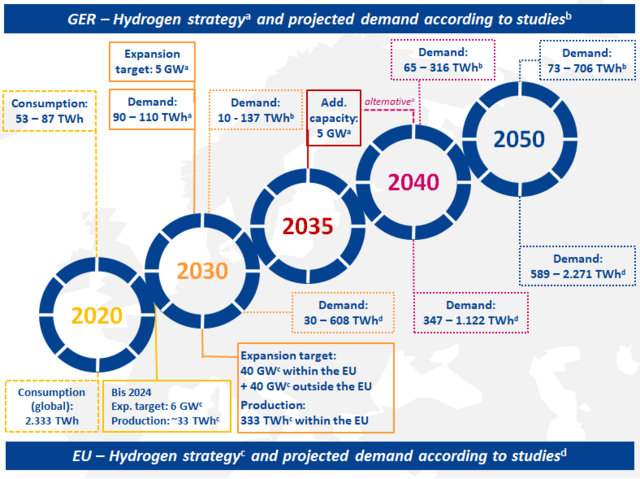// Future potential of electrolysis
The “European Green Deal” and its stated aim of wishing to achieve climate neutrality by 2050 at the latest place the spotlight on hydrogen, given the key role it will play in many ways, with the decarbonisation of hydrogen production as a raw material for industry, which has hitherto been largely based on fossil sources, along with the sharp increase in demand for hydrogen in the future, primarily due to the conversion of other industrial processes and to the “defossilisation” of the transport sector. Global hydrogen consumption currently stands at around 70 million tons per year. This is “only” the amount supplied to industry at present, however, to meet the raw material needs. Hydrogen as a fuel is still largely insignificant.
The German and European hydrogen strategy papers – both published in summer 2020 – underline the increasing importance of future national and international hydrogen markets. According to the German hydrogen strategy, there are plans to install hydrogen production capacity of up to five GW in Germany by 2030, with a further five GW to follow in Germany by 2035/2040. The European hydrogen strategy envisages the installation of at least 40 GW of hydrogen production capacity in the EU by 2030, with an additional 40 GW to come on stream in countries bordering the EU by then. This will involve considerable capital expenditure. An investment of between 24 and 42 billion euro is expected by 2030 just to develop the planned hydrogen production capacity in the EU. This will open up major commercial opportunities for industry in Baden-Württemberg, especially through the production of the necessary electrolysis plants. There is an increasing global demand for green hydrogen which is likely to drive dynamic growth in the market for plant and component exports in the future and result in significantly higher overall potential.
This raises various questions for potential market players, such as the following:
- What are the prerequisites for (successful) entry to the hydrogen market?
- How will the demand for hydrogen develop over time and what price and cost trends can be expected?
- What is the ratio of domestically produced green hydrogen to imported green hydrogen?
- What is the potential scope for adding value, generating sales and creating jobs in Baden-Württemberg?
These and other questions will be addressed in the “BW Electrolysis” project, and relevant information will be made available to the participating enterprises in Baden-Württemberg.



